ChatGPT opened the floodgates. But many people don’t realize there’s a whole world of generative AI tools and applications out there, just waiting to be explored.
Whether you’re struggling to overcome a case of writer’s block, lack the artistic aptitude to do your imagination justice, or just need a hand crafting efficient computer code, generative AI can help augment and streamline both your professional and creative endeavors. Yet, amid the seemingly endless variety of AI assistants currently on offer, finding the right one for your needs can prove a daunting task. So, let’s delve into some of the most impressive AI tools that are pushing the boundaries of innovation, including the best AI chatbots, the best AI image generators, and much more.
The best AI tools for image generation
Midjourney

One of the first AI image generators to be released back in 2022, Midjourney has proven immensely popular with users and art critics alike. It can output high-definition, photorealistic images in countless artistic styles based on natural language text prompts.
Originally only available through the company’s Discord server, Midjourney can now be accessed through a streamlined web portal. While the website’s gallery of generated art is free to browse, you will need to subscribe to a monthly service plan (which range from $10 to $120) in order to generate images of your own.
Ideogram

While not as creatively robust as Midjourney — only able to generate images in one of five preset artistic styles — Ideogram does offer a generous free tier that allows users to generate up to 40 images per day. Paid tiers range from $7 to $48 per month and offer a host of benefits, from additional compute resources and priority access to full-quality image downloads. The company also boasts an iOS app and an API that it claims will “offer superior image quality at a lower cost compared to other models.”
Dall-E 3

This is OpenAI’s in-house text-to-image generator and runs atop the company’s GPT-4 model. Originally released in September 2023, it was initially only available to paid tier subscribers. OpenAI expanded its availability to free tier users this past August, though you’ll only be able to generate two images per day at that subscription level. Dall-E 3 is also available through Microsoft’s Copilot chatbot.
Imagen 3

If you’re looking to create high-quality images without the strict production limits that ChatGPT enforces, Google’s Imagen 3 is a solid option. It’s available through the Gemini chatbot, including the free tier, and offers higher-quality outputs with fewer artifacts than its previous versions. Note, however, that the system will not generate images of people, famous or not, unless you subscribe to Gemini Advanced (which costs $20 per month).
Grok 2

Grok 2 is the text-to-image generator for people uninterested in adhering to copyright law. Developed for Elon Musk’s xAI company, and available on X, Grok 2 isn’t restricted by minor inconveniences like safety and legal guardrails, as other image generators are. Want to see Mickey Mouse fighting Darth Vader atop a 747 as it flies into the World Trade Center? Grok will generate it, no questions asked. You will, however, need to pony up $8 for a premium subscription to X in order to access it.
Gen 3 Alpha with Frames

Runway’s Gen 3 Alpha is a relatively new model, having been released in June of 2024, and is capable of creating both still images and video clips with nearly photorealistic quality based on the user’s natural language prompts. The company recently announced that it will begin integrating a new foundational model, dubbed Frames, into the Gen 3 platform that will offer unprecedented control over the image creation process, enabling users to generate multiple image variants while maintaining a specific aesthetic style, whether that’s mimicking 35mm disposable camera shots or retro anime motifs. Subscription prices run from $12 to $76 per month, though the company does offer a limited free tier as well.
The best AI tools for image editing
Luminar Neo
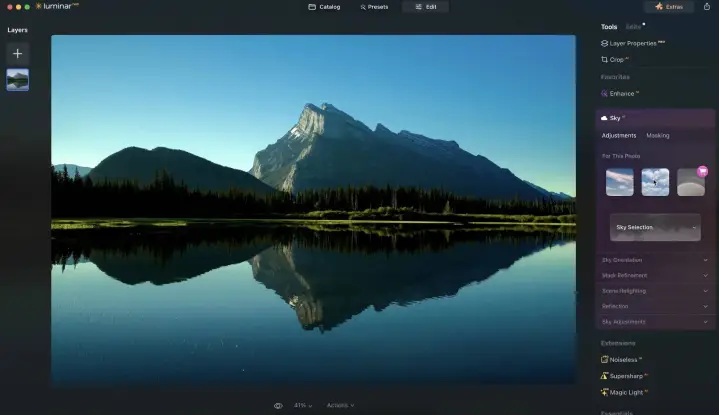
Skylum’s Luminar Neo is a photo editing suite designed with professional photographers in mind. It offers many of the same powerful tools as Adobe Photoshop, but outsources much of their functionality to AI. This enables users to accomplish numerous common tasks, from adjusting color balance and lighting levels to tweaking the look of the sky, water, and skin tones, with a single click. Luminar Neo might be a bit pricey for casual users, costing $421 for a yearly subscription or as a lifetime subscription for $577. It’s available on both Windows and Mac, as well as a plugin for Photoshop, Photos, and Lightroom.
Canva Pro
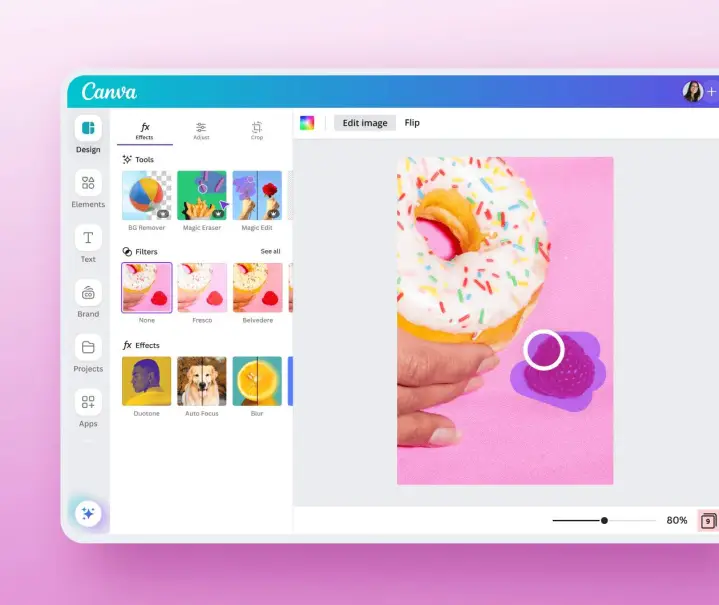
Canva is a multifunction creative platform that offers everything from digital whiteboarding, data visualization, and marketing material templates to photo, video, and YouTube editing features. While you can easily make minor adjustments like cropping, adding filters and adjusting aspect ratios using the site’s free editor, Canva Pro offers a number of additional AI-empowered tools.
Select, move, resize, and even erase individual objects within an image; extract and modify text on flattened images; and even generatively expand the image’s background, all with a few simple clicks. Canva Pro costs $120 per year for a single user license.
Pixlr Suite

This online photo editing suite has served as a free and user-friendly alternative to Photoshop since it was released in 2008. Last November, the company debuted a number of AI features including image generation, a generative fill tool, AI background removal, AI face swap, and image expansion to help round out the tool set’s functionality. While the interface is geared more for casual users and may not be as precise and granular as what Photoshop offers, you can’t beat free.
Topaz Photo AI

If you only need to do some light retouching work on your images, the Topaz Photo AI suite offers eight enhancement tools: Denoise, Sharpen, Upscale, Recover Faces, Remove Objects, Preserve Text, Adjust Lighting, and Balance Color. It’s not a true replacement for full-function photo editors like Photoshop, but it is available without an annual subscription, for a flat rate of just $199 with version upgrades costing $99.
Firefly AI

Adobe’s Firefly AI doesn’t just generate images and video from text prompts, it also empowers a number of AI features throughout the Adobe product ecosystem. That includes the Generative Fill tool in Photoshop, text effects in Adobe Express, vector and pattern generation in Illustrator, and Generative Extend in Premiere Pro. You will need to subscribe to Adobe’s Creative Cloud suite in order to access these features, though they can either be purchased individually (the image generator, for example, costs $5/month while Photoshop costs $23) or you can pick up all 20-plus Adobe apps for $60 per month.
Best AI for video generation
Luma Dream Machine

While Luma Dream Machine may be designed with fashion, marketing and filmmaking professionals in mind, it’s built as a subscription-based service with both casual and professional users in mind. Unlike conventional AI tools, Dream Machine does not require precise and exhaustive prompting to generate the desired effect, but rather, interprets the user’s natural language request intuitively. It also accepts multi-image prompting and single-image character references so users can show the AI what they have in mind. Luma does not offer a free tier, though a “hobbyist” subscription costs just $10 per month.
Kling

Kling AI video-generation system from China’s Kuaishou Technology offers photorealistic outputs on par with what we’ve seen from OpenAI’s Sora and is already available to users around the world. It can generate high-definition videos up to two minutes in length (double what Sora can) at up to 30 frames per second and 720p resolutions (slightly less than Sora’s 1080p output). Each clip starts out at just five seconds in length but can be extended in 4.5-second increments by purchasing additional credits. Just be warned that the system is blocked from generating politically-sensitive subjects.
Synthesia

Synthesia is a bit more niche than the other video generators we’ve discussed so far. It’s designed specifically to generate video avatars from the user’s text prompts making it ideal for business applications like onboarding and training videos, sales presentations, and internal communications. Users can choose from one of more than 130 avatar models speaking 140 different languages and over 60 video templates. The free tier allows you to generate a single three-minute video per month and your choice of nine avatars, while the $30/month Starter tier and $90/month creator tier offer significantly more benefits.
Vyond

Vyond offers similar functionality to Synthesia in that it generates AI avatars for training videos based on the user’s text prompts, however, this service relies on animated characters rather than live actors. You also have the option to record yourself performing specific actions or movements and Vyond will motion match its animation to them. Plans start at $49 per month, which also includes access to an added video editor, though anything you produce at that tier will be watermarked with Vyond’s logo.
The best AI for text generation
ChatGPT

ChatGPT, the chatbot that launched the AI boom in 2022, remains at the forefront of the industry with an estimated 200 million active weekly users. Trained on huge quantities of written content including websites, books, social media posts, and news articles, ChatGPT is equally adept at answering general knowledge queries and compiling computer code as it is at generating creative prose. It was also the first chatbot to offer a conversational feature in Advanced Voice Mode that allows users to interact with the chatbot as if it were a person, doing away with the need for text-based prompts.
ChatGPT is available on the web as well as on iOS and Android. It’s free to use, though subscribing to the $20/month ChatGPT-Plus plan will give you increased access to the company’s latest AI models and features.
Copilot
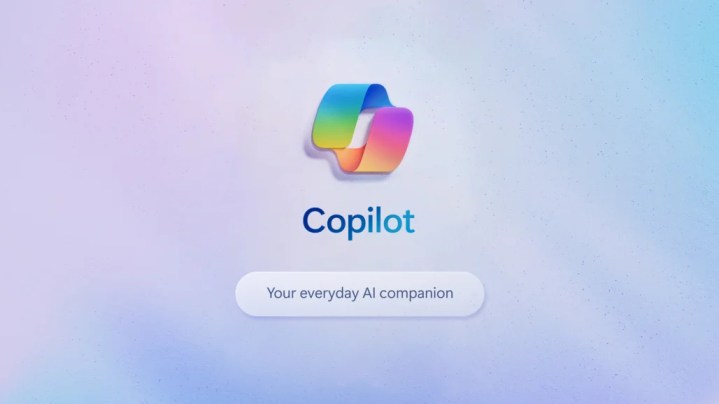
Copilot answers the question “what if ChatGPT worked natively within Microsoft’s 365 app ecosystem?” Which is exactly what it does. Microsoft has invested billions in OpenAI’s business and, as such, its Copilot AI runs atop the startup’s GPT-4o LLM.
However, Copilot is more than just a reskinned ChatGPT. For one, Copilot does not restrict users from generating images without paying for a subscription to its premium plan as ChatGPT does. For another, its functionality can be integrated across Microsoft’s products, helping users generate text in Word, create graphs and tables in Excel, and draft emails in Outlook.
Google Gemini

Google’s Gemini chatbot may have gotten off to a bit of a rocky start upon its official debut in February but the AI assistant has quickly grown into a potent rival to ChatGPT, offering much of the same functions and features. Those include the ability to generate text, images, video, audio, and code, converse with users verbally with Gemini Live, and integrate with Google’s Workspace app suite. It can gin up email responses in Gmail, search for files in Drive, create content for Slides, and draft text in Docs, all through the user’s natural language prompts.
Gemini is free to use and is available on the web as well as through its iOS and Android apps, but if you want to access the AI’s more advanced features (and Workspace integrations), you’ll need to subscribe to the company’s $20/month Google One AI Premium service.
Perplexity

Perplexity’s AI assistant offers a unique alternative to traditional search engines. Rather than simply return a list of websites in response to a user’s query as Google search does, this chatbot scours the internet for relevant information, then synthesizes an answer to the user’s question directly in the chat window. It essentially eliminates the need to click through to individual websites to find the information you’re looking for.
Built atop the GPT-4 model and available on Android, iOS, as well as on the web, Perplexity is free to use. The company also offers a Pro subscription plan for $20/month (or $200/year) that grants you access to additional AI models including GPT-4 Omni and Claude 3 Sonnet and Haiku, as well as a host of additional benefits.
Jasper

Unlike generalized chatbots like ChatGPT and Gemini, Jasper AI is all business. It is designed to generate text for emails, blogs, social media posts, and marketing materials, all while maintaining your company’s distinctive tone, voice, and brand style. The platform includes Jasper Chat, which assists with research tasks and offers writing advice, as well as can help maximize the SEO score of your marketing content. Jasper is only available on a subscription basis, with plans starting at $40 per month per user, though the company does offer a seven-day trial.
The best AI for audio and voice generation
ElevenLabs

ElevenLabs knows how to make a machine talk. The company is a leader in generative speech technology, offering a variety of audio-centric services from automatic voice dubbing and cloning to text-to-speech and text-to-SFX. Users can select from thousands of unique voices (including those of famous celebrities), all trained on public domain and licensed data, in any of 32 languages. Ideal for podcasting, audio book narration, and conversational AI applications, the company’s products are available at a variety of pricing tiers ranging from free up to $99 per month.
Speechify

Why read a document when you can have Speechify read it to you four and a half times faster? The company’s voiceover technology can recite nearly any document you present to it in one of 200 voices (including your own through its voice cloning feature) in more than 60 languages. Speechify is available as a Chrome extension, a Mac app, a web app, iOS or Android app. The mobile apps can also read physical documents using your phone’s camera to scan the page. Speechify’s free tier limits you to simple text-to-speech in just 10 voices, while the $12/month premium tier unlocks the service’s full functionality.
Respeecher

Respeecher specializes in voice cloning for celebrities, content creators, voice actors, game designers, and other professional applications. The company’s AI model essentially enables one person to speak in the voice of another. “We take recordings of the ‘target voice’ (the voice that is being replicated), train our system, and apply it to a ‘source speaker’ (the actor reading the lines),” the Respeecher’s FAQ explains. “It features all the emotions, intonations, and nuances of a real human voice.”
The company offers a wide range of celebrity voices including Chris Farley and Richard Nixon, the latter of which earned Speechify an Emmy in 2019. Subscription plans start at $18 per month for basic text-to-speech (up to 100,000 characters per month and range up to $500 per month for the Power tier, which offers 900 minutes of speech-to-speech and 3 million characters of text-to-speech generation in more than 100 voices and 13 accents.
Controlla Voice

If you fancy yourself a musician but can’t carry a tune, Controlla Voice can help. Its generative model can train an “AI Singing Voice” that sounds like you, based on 15-30 minutes of sample audio, then apply it to songs from the company’s extensive catalog, or blend your voice with others from their licensed stable of voice actors to generate unique vocals. You can even convert the vocals in existing songs from other artists into your voice for low-effort covers. Subscription prices run from $12 to $30 per month.
The best AI for coding
Claude
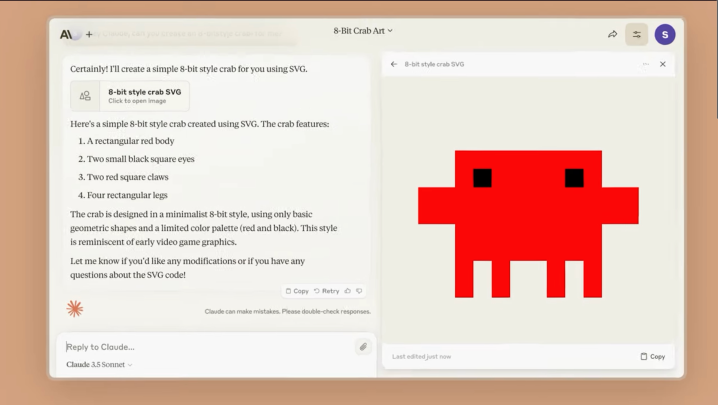
Anthropic’s Claude chatbot may not be able to generate images or speak to you conversationally, but it utterly excels at coding applications. Its latest iteration, Claude 3.5 Sonnet, drastically outperforms the likes of Gemini 1.5 Pro and ChatGPT-4o across a broad swath of leading industry benchmarks. Claude was also the first chatbot to offer a collaborative window (dubbed Artifacts) that previews what the AI is generating outside of the chat stream. The chatbot is available free to all users on the web, iOS, and Android, though subscribing to the $20/month Pro or $30/month Teams tiers will grant you priority access to the latest and greatest models that Anthropic has to offer.
GitHub Copilot

Developed through a partnership between Github and OpenAI, GitHub Copilot acts as an AI autocomplete, to help users in the Visual Studio Code, Visual Studio, Neovim, and JetBrains IDEs generate code faster than they can on their own. Users can present Copilot with a coding problem, phrased in natural language, and the assistant will automatically generate a solution code. Conversely, it can also explain what a given snippet of code does as well as convert snippets between various coding languages. You can use Github Copilot for free, though upgrading to either the $4/month Pro or $21/month Enterprise tiers will, of course, give you additional resources and features.
Amazon CodeWhisperer

Similar to Copilot, Amazon’s CodeWhisperer is a general use coding assistant that will automatically generate suggestions and code recommendations based on your existing inputs, in real time. It’s available for the JetBrains and Visual Studio IDEs and also supports natural language-to-bash translation in the Mac command line. The free tier only offers limited access to the system’s more advanced features, so you’ll have to pony up $20/month if you want to unlock its full capabilities.
Cursor AI

Cursor AI is a coding assistant in the same vein as Codewhisperer but can offer autocomplete suggestions across multiple lines of code, based on your previous inputs. It also offers a smart rewrite function that automatically corrects your typos and syntax errors so you spend less time tracking down errant quotation marks and parentheses while debugging, as well as cursor prediction that guesses where your cursor needs to be next, enabling you to navigate through your project faster and more efficiently.
It even offers a chatbot assistant (leveraging GPT-4, GPT-4o, and Claude 3.5 Sonnet) that can answer questions about either the entire active file or specific selected code blocks. The chatbot can even edit that highlighted code based on your natural language instructions. Cursor AI is available for the Mac, Windows, and Linux operating systems. You can try it out free for two weeks before a $20/month Pro or $40/user/month Business subscription is required.
The best AI to integrate with the rest of your app ecosystem
Meta AI
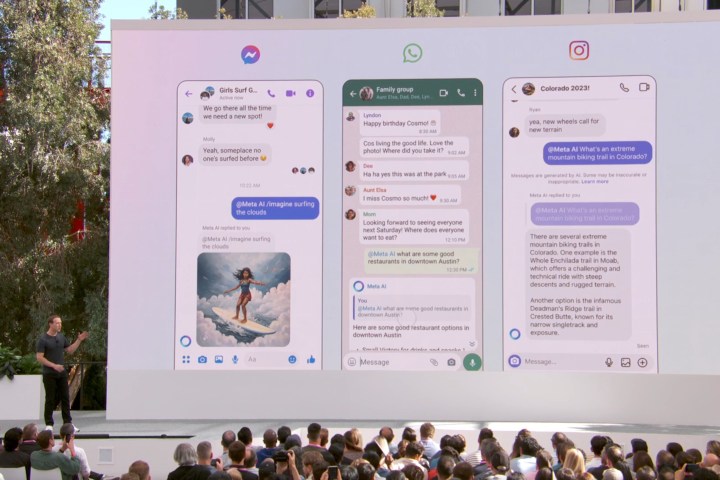
Meta, Facebook’s parent company, has been investing heavily in AI over the past few years and has recently begun incorporating the smart features found in rivals like Gemini and Copilot to its own product portfolio. “More than 400 million people are using Meta AI monthly, with 185 million people using it across our products each week,” the company boasted in a September blog post.
The company now offers a conversational AI similar to Advanced Voice Mode in Messenger, Facebook, WhatsApp, and Instagram DM. It can answer questions about photos shared in your group chats, generate custom backgrounds for images you reshare from your feed to Instagram Stories, and automatically translate the audio of your Instagram Reels. It can also generate images to share on your feed, Stories, and set as your Facebook profile picture. So when you find yourself wondering why there’s so much AI slop clogging up Facebook and Insta, understand that it is a feature Meta has spent billions developing, not a bug.
365 Copilot

Microsoft has dumped north of $10 billion into its partnership with OpenAI, so of course it’s going to shoehorn ChatGPT’s generative capabilities into every single product it possibly can. In addition to the Copilot chatbot itself, Microsoft has developed and released Copilot Pages, which function much like Claude’s Artifacts or ChatGPT’s Canvas. The company has also integrated it into Outlook to help you manage your inbox by prioritizing which messages to respond to first and quickly draft email replies.
365 Copilot can also help you rapidly establish a cohesive narrative in your PowerPoint presentations by generating pitch decks whole cloth from your natural language prompt that maintain a consistent tone and brand voice. In Excel, Copilot does the heavy lifting of generating formulas, graphs, and charts based, again, on the user’s prompt. And in Teams, Copilot can monitor your video meetings and provide summaries of what happened as well as generate actionable item lists based on what was discussed.
Google Gemini

Gemini does for Google’s Workspace app suite what Copilot does for Microsoft’s. The AI assistant can help draft emails in Gmail, write documents in Docs, generate graphs and charts in Sheets, create and modify slides in Slides, find files in Drive, and provide live-translated captions and take notes in Meet. If you don’t already have a personal Google One AI Premium subscription, you’ll have to ask your Workspace admin to grant you access.
Apple Intelligence

Apple Intelligence may be the new kid on the AI block, but it is promising to be more deeply integrated within its product ecosystem than any other currently on the market. Designed to serve as an overarching agent acting on the user’s behalf, it promises to streamline monotonous everyday tasks, make Siri a better conversationalist, automate proofreading and text summarization across the company’s myriad apps, and offer lightning-fast image generation. It is currently available to all devices running iOS 18, iPadOS 18, and MacOS Sequoia — basically, the iPhone 15 Pro and 15 Pro Max (and newer), as well as iPads and Macs with M1 or newer chips.




